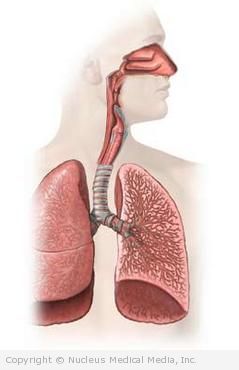Mediastinotomy
(Chamberlain’s Procedure; Anterior Mediastinotomy)
Mediastinotomy – Definition
The mediastinum is the area in the middle of the chest between the lungs. A mediastinotomy is the creation of a small opening in the upper chest into the mediastinum. This opening allows the doctor to examine the area between and in front of the lungs.
Mediastinotomy – Reasons for Procedure
This procedure is done to examine the lungs and chest. Your doctor might take tissue samples ( biopsy). These samples are examined under a microscope to check for diseases like:
- Cancer of the lungs, bronchi, and chest tissue
- Lymphoma — cancer in the lymphatic system (eg, Hodgkin’s disease)
- Infection
- Inflammation
- Sarcoidosis — a condition that causes swelling (inflammation) in organs like the lungs, liver, lymph nodes, and spleen
Mediastinotomy is also done to find out if lung cancer has spread.
Mediastinotomy – Possible Complications
Complications are rare, but no procedure is completely free of risk. If you are planning to have a mediastinotomy, your doctor will review a list of possible complications, which may include:
- Bleeding
- Infection
- Hoarseness
- Chylothorax — leakage of lymphatic fluid into the chest
- Damage to organs in the chest
- Pneumothorax (collapsed lung)
Factors that may increase the risk of complications include:
- Previous mediastinoscopy (a tube that lets your doctor see into your chest)
- Previous chest or neck surgery
- Pregnancy
- Diabetes or other chronic conditions
- Smoking
Discuss these risks with your doctor before the procedure.
Mediastinotomy – What to Expect
Prior to the Procedure
Your doctor will explain the procedure to you and ask you to sign a consent form. You will be asked to stop eating and drinking for 8-10 hours before the procedure. Your doctor will tell you whether you should:
- Take any medicines before the procedure
- Stop medicines like insulin, aspirin, or blood-thinning medicines
On the day of the procedure:
- You will be asked to remove any jewelry, glasses, contact lenses, or dentures.
- You may be given medicines to help you feel sleepy and relaxed.
- Be sure to tell your doctor if you have any allergies.
- You will need someone to drive you home after the procedure.
Mediastinotomy – Anesthesia
You will receive a general anesthetic through an IV in your hand or arm. This will block any pain and keep you asleep throughout the procedure. Once you are sedated, a breathing tube will be placed in your throat to help you breathe.
Mediastinotomy – Description of the Procedure
- You will lie on your back on an operating table.
- Your skin will be cleaned with an antiseptic solution.
- The doctor will make a small cut in your chest.
- The doctor will move your muscles aside so that she can examine the space between your lungs and heart.
- She may take tissue samples from your lungs, lymph nodes, or other parts of your chest.
- When the procedure is finished, she will close the opening with stitches.
- The wound will be covered with a dressing.
Mediastinotomy – Immediately After the Procedure
After the procedure, you will be taken to the recovery room. If all is well, your breathing tube will be removed. The tissue samples will be sent to the laboratory for testing.
Mediastinotomy – How Long Will It Take?
30 minutes to 2 hours
Mediastinotomy – How Much Will It Hurt?
General anesthesia prevents pain during surgery. Your doctor may give you pain medicine for pain and tenderness after the procedure.
Mediastinotomy – Average Hospital Stay
This procedure can be done in an outpatient setting or as part of your hospital stay. The usual length of stay is up to 24 hours, if there are no unforeseen complications. Some people may need to stay in the hospital for 1-2 days.
Mediastinotomy – Post-procedure Care
At the Hospital
- You will be taken to the recovery room after the procedure until the anesthetic wears off.
- Your doctor may order a chest x-ray to check for bleeding or air inside your chest space.
At Home
- When you return home, do the following to help ensure a smooth recovery:
- You may feel sleepy for several hours or even 1-2 days following anesthesia. Do not drive during this time.
- You may have a sore throat from the tube placement.
- Use throat lozenges.
- Gargle with warm water.
- Keep your wound clean and dry.
- Wash your hands before touching the wound.
- Use a soft washcloth to gently wipe the wound with soap and water.
- Change the dressing as instructed by your doctor.
- Be sure to follow your doctor’s instructions.
Mediastinotomy – Call Your Doctor
After you leave the hospital, contact your doctor if any of the following occurs:
- Redness, swelling, pain, or bleeding from the wound
- Chest pain
- Swelling in the neck
- Difficulty swallowing
- Hoarseness that lasts more than a few days or worsens
- Shortness of breath
- Signs of infection, including fever and chills
- Joint pain, fatigue, stiffness, rash, or other new symptoms
In case of an emergency, call for medical help right away.

